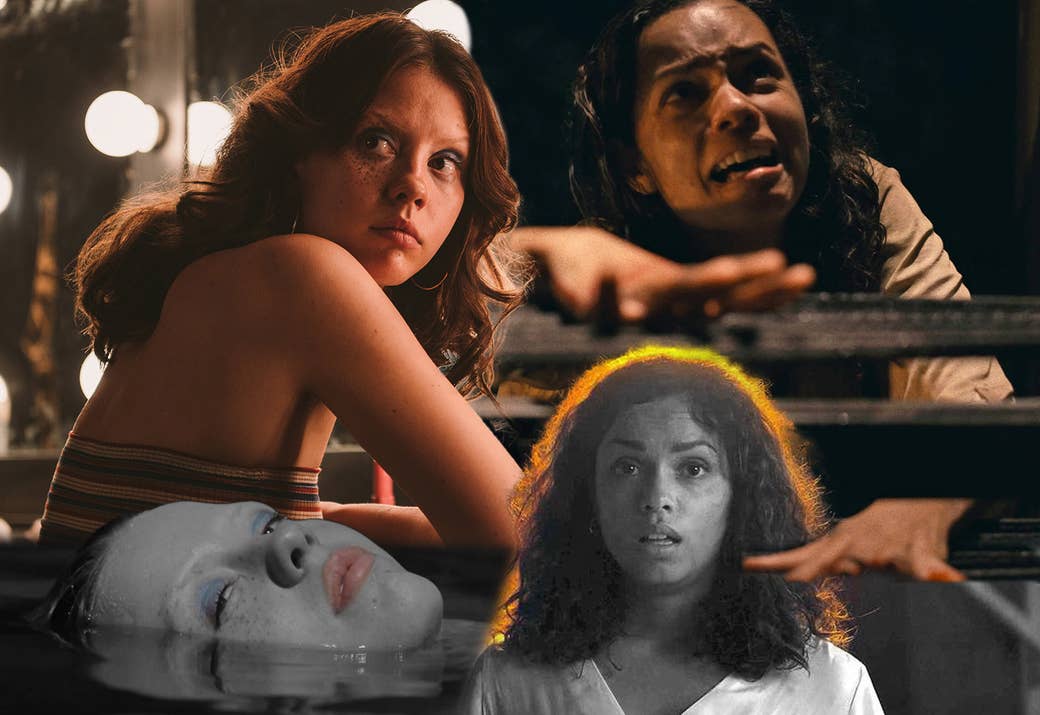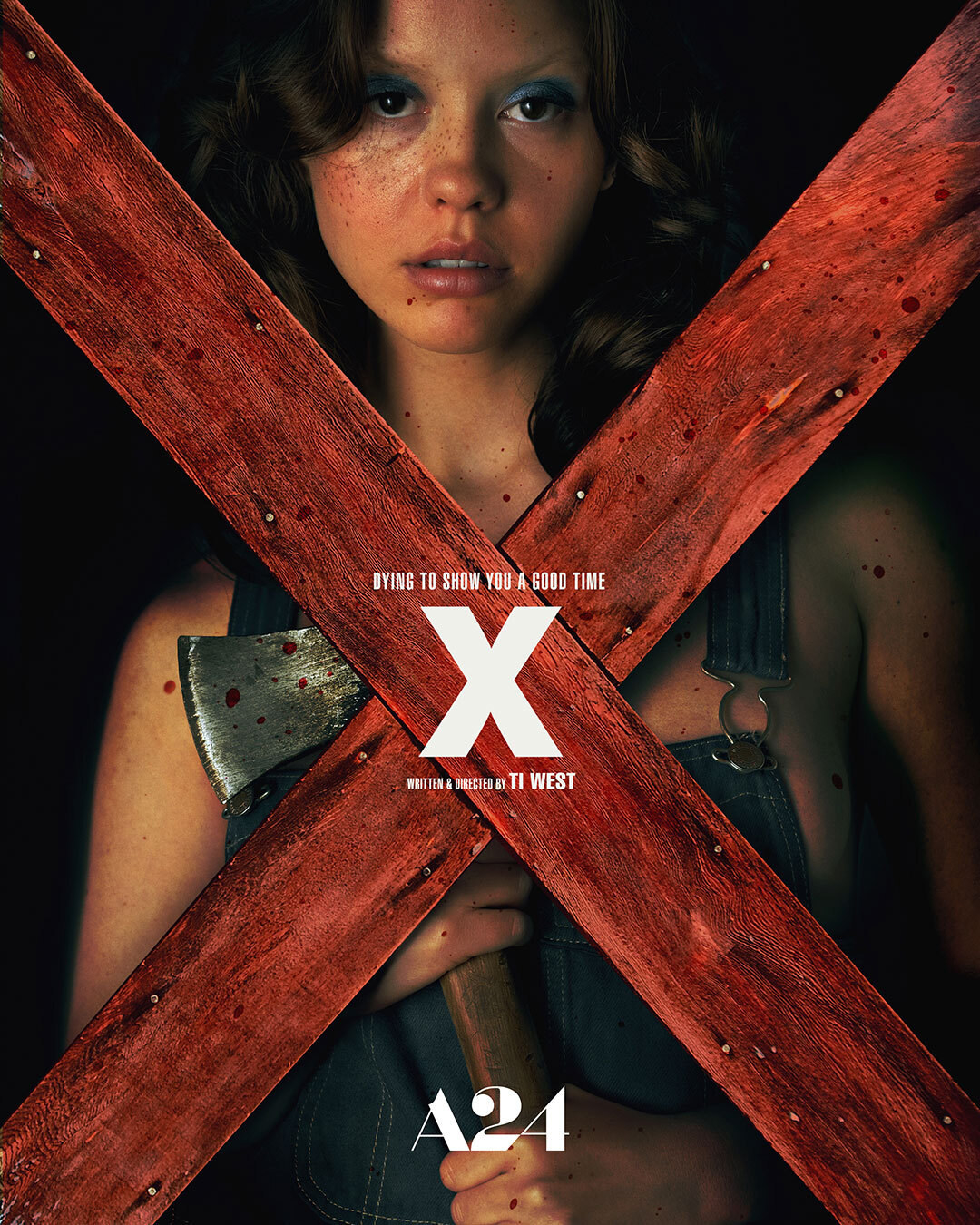
Warning: This post contains spoilers.
Zach Cregger’s Barbarian (now streaming on HBO Max) was a sleeper hit this September, making $40 million from a $4 million budget. The low-budget horror movie about a woman who discovers someone else living in her Airbnb received a groundswell of love from critics and horror fans. It happily took the spot Ti West’s X had occupied earlier this summer. Though the two have little in common stylistically — X, set in 1979, is clearly inspired by slasher movies and exploitation flicks of the period, while Barbarian breaks apart tropes of contemporary “elevated” horror — their villains and central conflict are quite similar. Both films feature (spoilers ahead!) elderly women as their killers and young, transient artists as their victims.
X fully embraces its late-’70s groove. Set in the so-called golden age of porn, the film depicts a group of amateur pornographers who decide to make a new type of artistic adult film in a rented farmhouse. They are immediately met with hostility upon their arrival by older, gun-wielding Howard (Stephen Ure). But his wife, Pearl (Mia Goth), becomes fixated on the group and begins to stalk the cast, while also attempting to seduce one of the actors, Maxine. Barbarian similarly positions a young cast of ambitious artists against a defensive older class: Tess (Georgina Campbell) is in town to interview for a research position on a music documentary, only to discover that her Airbnb, owned by sitcom actor AJ (Justin Long), has been double-booked. Her fellow guest, Keith (Bill Skarsgård), is a prominent local musician and potential subject in her work. None of these three know that the former owner, Frank (Richard Brake), is still living underneath the house. Below the basement lair he created to abduct women, he resides alongside his daughter and a gnarled monster called simply “the Mother,” who is likely his victim.

X and Barbarian both play with the “psycho-biddy” horror trope exemplified by movies like Whatever Happened to Baby Jane? (1962), Sunset Boulevard (1950), and even Snow White (1937). The “psycho-biddy” is an older, unstable woman whose violence is activated by jealousy, sexual desire, and resentment. Her ire is often focused on young women, whose youth and beauty she openly envies. The genre is a complicated response to Hollywood’s ageism and its one-dimensional view of women actors as maiden, mother, or crone. It both comments on and exploits the anxieties — as they are perceived by male filmmakers — that women have about their value in a youth-oriented culture. As Taylor Swift put it in “Anti-Hero” on her most recent album, Midnights: “Sometimes I feel like everybody is a sexy baby / And I’m a monster on the hill.”
It is only recently that we have seen warm onscreen portrayals of sexually active older women. Compare the depiction of the 50-year-old women of And Just Like That — stylish, sexually adventurous, and absurdly glamorous — to that of Golden Girls, where the women are framed as retirees and grandmothers. Perhaps the most famous female seducer of cinema, Mrs. Robinson of The Graduate (1967), was played by Anne Bancroft, who was only six years older than her costar Dustin Hoffman. Mrs. Robinson is sexually aggressive, manipulative, and falsely accuses Hoffman’s Benjamin of rape upon being rejected — a trifecta of evil female behavior. May–December romances in Hollywood are so universally gendered and heteronormative (older man, younger woman) that a movie like Good Luck to You, Leo Grande (2022), where a 55-year-old woman (Emma Thompson) whose spouse has died hires a young male sex worker, is still a distinct novelty.
The genre is a complicated response to Hollywood’s ageism and its one-dimensional view of women actors as maiden, mother, or crone.
X and Barbarian reframe the so-called psycho-biddy conflict as a territory dispute. Pearl is not a roving serial killer. She is set off by the sudden intrusion on her home and kills after being unexpectedly confronted with objective proof of her old age and lack of sexual viability. The Mother only emerges from her basement at night to hunt in the derelict neighborhood that’s become her enclave. She abducts two victims to become her pseudo-children when they enter her basement dwelling, and she kills anyone who stands in the way of her warped caretaking. These villains have clear boundaries. They kill when new people do not conform to their rules and disrupt the isolated world they’ve established.
Making the victims ambitious artists further cements these “psycho-biddies” as relics of a time long gone. These two films explore not just the concerns millennials and Gen Z have about aging but the generational conflict between the under-40 crowd and baby boomers. It’s more than eye-rolling contempt for a fuddy-duddy past generation. Pearl and the Mother are not simply out-of-touch elders; they’re villains hungry for youth, landlords who terrorize their tenants. In these portrayals, we see the same anger that fueled the “OK, boomer” or “Karen” memes — an open resentment of the generations who destroyed the economy, the environment, and the political system while still lecturing the youth on personal responsibility.

Mia Goth, channeling the wide-eyed, rhapsodic nerviness of classic horror queens like Sissy Spacek or Shelley Duvall, plays dual roles in X as both final girl Maxine and her terrorizer, whose backstory is illuminated in West’s 2022 prequel film Pearl. In Pearl, we learn that it’s actually Pearl who owns the house, not Howard.
Pearl has spent her entire life in that house, once ruled by her strict German mother, Ruth, who would be a caricature were Tandi Wright’s performance not so sympathetic. Set during the 1918 flu pandemic, Pearl shows the younger woman (Mia Goth) taking care of her near-comatose father, only leaving the farm to fetch his medicine and sneak into the local cinema. (These films feature star-making performances from Goth, who flexes her versatility with two fully realized and distinct characters; she also served as a cowriter and executive producer for Pearl.) She is already married to Howard, but he has enlisted in WWI despite her protests. Both Ruth and Pearl are openly miserable, lonely, and resent having been abandoned by their husbands — but there is no shared sentiment between them. Ruth does not merely want Pearl to mature: She wants Pearl to take on the same adulthood Ruth has, one marked by unending domestic responsibility, martyrdom, and quiet despair. In the same way Pearl will resent the actors of X, Ruth seethes over her daughter’s naivete and still-glimmering hope for the future.
X reveals that Maxine is the daughter of a Christian fundamentalist whose preaching Pearl and Howard watched on television. In Maxine, we see the realization of Pearl’s dreams to abscond from a conservative home in pursuit of fame. Maxine is not just attractive and sexually desirable — she’s able to express her own sexual desires without rejection. Her arrival disrupts Pearl’s self-contained world, forcing Pearl to confront her dissatisfaction with the life she never wanted. Goth is almost, but not quite, unrecognizable as the elderly Pearl under six hours of makeup and practical effects, reminding us that Maxine’s youth and beauty are ephemeral.
The flecks of jealousy, lust, and despair we see in X’s Pearl are rendered fully in the prequel: Pearl threatens her conventionally pretty and upwardly mobile sister-in-law, brings herself to orgasm while grinding on a scarecrow, and secretly dances in Ruth’s Edwardian dresses (Psycho allusion intentional). We also see her early aptitude for brutal violence. Pearl commits many minor acts of sadism, but it’s her theft of an alligator egg that feels most symbolic of what’s to come. Pearl brings the egg back to the farmhouse but she has no plans to hatch and raise the gator herself. Instead, she crushes the egg with a smile, a clear rejection of motherhood, the vulnerable, and the young. It’s fitting that Pearl’s first victims are her mother, bohemian lover, and father, a Freudian trilogy who represent barriers to her freedom. Pearl is not an unfeeling sociopath; rather, she has too much feeling. Much like in her beloved movie musicals, where protagonists are so overcome by emotion they have to dance, when Pearl boils over, she has to kill.
As she claims her final victim, we see that Pearl will never leave her farmhouse. She has accepted that the home is her true birthright now that her dreams of stardom have been crushed. She serves moldy food to corpses dressed in their Sunday best, constructing a funhouse version of the tidy home her mother once ran. The home now reflects how Pearl always felt about it: a decrepit, rotting torture den. She has tied herself to her prison, but has not taken on her mother’s penchant for suffering in silence.

Barbarian’s Mother is similarly a physical manifestation of her house of horrors. Her malformed nature is explained as the result of generations of rape and incest by Frank. Underneath Frank’s basement den, where he films and catalogs his many violations, is a long tunnel full of cages and nests. Among them is a room where an informational VHS tape about the joys of childrearing and breastfeeding seems to play on a loop — messages that have clearly warped the Mother’s bestial mind. Tess, the only other major female character in the movie, is smart enough to understand that the Mother’s behavior is the result of maternal instinct distorted into monstrosity and plays along, unlike her fellow male victims.
Both Pearl and the Mother operate on childish impulses. Pearl throws tantrums when she feels rejected; the Mother physically rips apart her pseudo-children when they don’t comply. They rely on instinct and intuition, rather than logic, to hunt their victims. Most tragically, neither understands why they are so grotesque. Both serve as investigations (Pearl more intentionally than the Mother) of concepts Hollywood has glamorized, exaggerated, and attached to women: so-called hysteria, jealousy, and childish simplicity.
The “psycho-biddy” genre has been maligned as anti-feminist — unsurprising from a genre also cheekily referred to as “hagsploitation.” Films with this trope have been accused of fetishizing female youth and beauty and demonizing older women, especially older women who openly seek sexual pleasure. But in both X and Pearl (and likely the forthcoming denouement to the series, MaXXXine), we see a well-rounded and often gleeful exploration of two women whose specificities make them compelling. Maxine and Pearl are ambitious women reacting to the pressures of their time and responding with their own desires. Pearl never excuses or victimizes the young Pearl. She has always had violent desires and she chooses to act on them — her family and loneliness might have shaped her, but she decides to become a monster.
Conversely, Barbarian is ultimately not a movie about women but about what men do to them. Justin Long’s AJ is a disarmingly “nice guy” who downplays his serial abuse of women as misunderstandings, including his recent rape of a co-star. Upon entering owner Frank’s lair and seeing the horrific tapes he’s created, AJ is repulsed. He clearly distinguishes what he did to his costar — which he’s still refusing to admit was rape — from what Frank did. He is the embodiment of the softer side of toxic masculinity, the type wielded by savvier predators who use friendliness as a tactic.
The Mother is the exact kind of villain a redpilled creep like AJ is unable to counter. She’s the ultimate helicopter mom, unable to distinguish children from adults, forcing her captives to bottle- and breast-feed. She demands perfect obedience from her children and violently punishes them when they refuse. When they leave her domain, she stalks them and attacks anyone who might be a corrupting influence and take them from her. And none of this childrearing seems to have worked: She’s completely alone besides Frank, who she is still terrified of. Her literally overbearing maternal nature is repulsive to her victims but also painfully pathetic.
Ultimately, the Mother is pitiable. A territorial animal, she doesn’t have the free will of a monster like Pearl, whose humanity and agency are fully depicted. The Mother is an abomination manifested from the sins committed by her father — another horrific consequence of the boomer generation’s insatiability.
These movies reanimate perennial fears of aging, older women, and one’s fading relevance.
Anxious times are good for genre films. In an era marked by apocalyptic dread and intergenerational resentment, X and Barbarian are timely depictions of youth anxiety toward a territorial older class and an older generation’s disdain for an entitled, aimless youth. While Barbarian is closer to a classic creature feature — notably, the Mother is played by a male actor — X and Pearl disrupt traditional narratives of feminine monstrosity, humanizing Pearl without exonerating her. Pearl is a response to male slashers like Norman Bates or Leatherface, two highly emotive villains who rule, maybe reluctantly, over a decaying miniature empire. These movies reanimate perennial fears of aging, older women, and one’s fading relevance. We also see the painful loneliness that often comes with old age in an increasingly individualistic world. “All this isolation has been enough to make one mad,” Pearl’s sister-in-law says offhand as Pearl knowingly looks on. It’s what we do with the madness that sets us apart. ●
